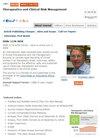Umbilical Vascular Thromboembolism: High-Risk Factors, Diagnosis, Management, and Pregnancy Outcomes: A Scoping Review
IF 2.8
3区 医学
Q1 Pharmacology, Toxicology and Pharmaceutics
引用次数: 0
Abstract
Abstract: Umbilical vascular thromboembolism is a rare condition that can lead to serious consequences such as fetal hypoxia, fetal growth restriction, and even stillbirth. However, there is currently a lack of research on the pathology, pathogenesis, clinical management, and prognosis of this condition. Therefore, the purpose of this article is to analyze this condition’s high-risk factors, clinical characteristics, pregnancy management, and discuss its corresponding pregnancy outcomes. Databases such as PubMed are searched using the relevant keywords of umbilical vascular thromboembolism in worldwide. And related information is analyzed such as maternal risk factors, fetal risk factors, umbilical cord and placental risk factors, and pregnancy outcomes. The literature search yields 113 articles, 64 of which meet the inclusion criteria for umbilical vascular thromboembolism. There are 4 retrospective cohort studies and 8 case series, the rest are all case reports. A total of 262 cases of umbilical vascular thromboembolism are found. The most common maternal complications and fetal related risk factors are diabetes (25 cases, 9.5%) and stillbirths (106 cases, 40.5%), respectively. Among these 262 cases, 98 (37.4%) cases are found by prenatal ultrasound to have umbilical vascular thromboembolism and the fetus is in a viable state with complete clinical information. In addition, considering the effectiveness and safety of low molecular weight heparin in thromboembolic conditions, twenty-four patients of umbilical artery thromboembolism attempted to use low molecular weight heparin during observation. Maternal diabetes was the highest risk factor for this condition. When umbilical artery thromboembolism occurs, the incidence of stillbirth increases. Premature patients with this condition can continue their pregnancy under close external monitoring. However, due to the small sample size, further research is needed.Keywords: umbilical vascular thromboembolism, umbilical vein thromboembolism, umbilical artery thromboembolism, fetal growth restriction, umbilical vein varix, low molecular weight heparin
脐血管血栓栓塞症:高风险因素、诊断、管理和妊娠结局:范围综述
摘要:脐带血管血栓栓塞症是一种罕见病,可导致胎儿缺氧、胎儿生长受限甚至死胎等严重后果。然而,目前对这种疾病的病理、发病机制、临床治疗和预后的研究还很缺乏。因此,本文旨在分析该病症的高危因素、临床特点、妊娠管理,并探讨其相应的妊娠结局。本文以脐带血管血栓栓塞症为关键词,在全球范围内对PubMed等数据库进行了检索。并分析了相关信息,如母体风险因素、胎儿风险因素、脐带和胎盘风险因素以及妊娠结局。文献检索共获得 113 篇文章,其中 64 篇符合脐带血管血栓栓塞症的纳入标准。其中有 4 篇回顾性队列研究和 8 篇系列病例,其余均为病例报告。共发现 262 例脐血管血栓栓塞。最常见的母体并发症和胎儿相关风险因素分别是糖尿病(25 例,9.5%)和死胎(106 例,40.5%)。在这 262 例中,98 例(37.4%)通过产前超声检查发现患有脐带血管血栓栓塞,且胎儿处于存活状态,临床资料完整。此外,考虑到低分子量肝素在血栓栓塞情况下的有效性和安全性,24 例脐动脉血栓栓塞患者在观察期间尝试使用低分子量肝素。产妇糖尿病是导致这种情况的最高风险因素。发生脐动脉血栓栓塞时,死胎的发生率会增加。患有这种病症的早产儿可以在密切的外部监护下继续妊娠。关键词:脐血管血栓栓塞症;脐静脉血栓栓塞症;脐动脉血栓栓塞症;胎儿生长受限;脐静脉曲张;低分子量肝素
本文章由计算机程序翻译,如有差异,请以英文原文为准。
求助全文
约1分钟内获得全文
求助全文
来源期刊

Therapeutics and Clinical Risk Management
HEALTH CARE SCIENCES & SERVICES-
CiteScore
5.30
自引率
3.60%
发文量
139
审稿时长
16 weeks
期刊介绍:
Therapeutics and Clinical Risk Management is an international, peer-reviewed journal of clinical therapeutics and risk management, focusing on concise rapid reporting of clinical studies in all therapeutic areas, outcomes, safety, and programs for the effective, safe, and sustained use of medicines, therapeutic and surgical interventions in all clinical areas.
The journal welcomes submissions covering original research, clinical and epidemiological studies, reviews, guidelines, expert opinion and commentary. The journal will consider case reports but only if they make a valuable and original contribution to the literature.
As of 18th March 2019, Therapeutics and Clinical Risk Management will no longer consider meta-analyses for publication.
The journal does not accept study protocols, animal-based or cell line-based studies.
 求助内容:
求助内容: 应助结果提醒方式:
应助结果提醒方式:


